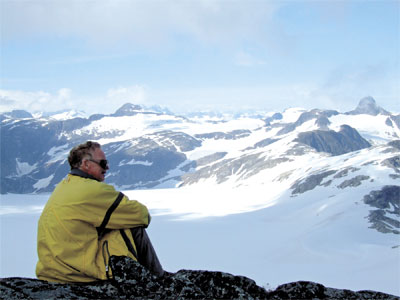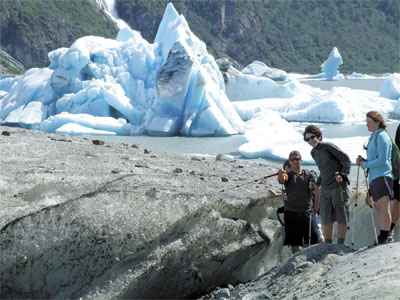AUGUST 31, 2011
Councilman McGuire takes a trek through the Juneau Icefields
‘For the next three days, walking and climbing stairs was difficult for me’
JUNEAU, Alaska – “A cruise it was not,” said Cave Creek Councilman Thomas McGuire of his third trip to Alaska, adding, “It was a trip in the memory of Cave Creek author Homer Smith (From Desert to Tundra, 1971).”
McGuire said his third trip to Alaska was a unique experience, as he reminisced about his first visit, which was “a road trip in 1972 along the legendary Alaska Highway, built across tundra and mountains during World War II.”
The road was constructed to open an inland supply route to Alaska amidst fear the Japanese armed forces might establish a mainland beach-head in North America. In fact, a year later Japanese troops did invade, holding two remote outposts in the Aleutian Islands.

Councilman Thomas McGuire is pictured on Observation Peak over the Lemon Creek Glacier. The Juneau Icefields seen in the distance extend on into Canada.
McGuire said, “Twenty years after my first Alaska trip, my wife and I booked a cruise up the Inland Passage. But I was restless to experience more than distant mountain views and tourist oriented ports of call.”
This summer, McGuire accepted an invitation to accompany six students and two former teaching colleagues to participate in the Juneau Icefields Research Program, a program established in 1946 to give students an opportunity to participate in research related to Alaskan glaciers.
McGuire’s backpack adventure began with a 13-hour climb from sea level up to Camp 17 at an elevation of 4,200 feet.
Commencing in the coastal rain forest, the group crossed three meltwater streams on narrow single-log “bridges.”
Next, they climbed through the “vertical swamp” past several beautiful arctic tarns (ponds and lakes) and onto the treeless sub-arctic mountain tundra.
A shortcut up a snowy coulior (mountain gully) led to a steep snow covered glacier on a rocky ridge between two active glaciers and Field Camp 17.
“Most of the project’s senior members take a short helicopter ride to the icefield camps,” said McGuire, 66, who was later informed he was the oldest person to ever endure the lengthy climb up to Field Camp 17.

Students are seen at the lower end of the Mendenhall Glacier in Juneau, Alaska.
The camp consisted of primitive wooden buildings with no running water and electricity only available during the evening hours.
After going two and a half weeks without showers, McGuire said, “Surprisingly, it was not a problem.”
And, as summers go in the north country, the sun sets at about 10 p.m., followed by a very brief nightfall and very early sunrise.
Explaining the Icefields program, McGuire stated, “A critical aspect of the study of any glacier is establishing a mass balance between accumulation and ice melt.
“The process begins with the gradual compaction of approximately 20 feet of snow that falls above Juneau each winter. Some of the snow melts and evaporates during the warmer months, but most of it changes to ice with depth, and begins its slow journey down-slope to where it melts into surging mountain streams.”
He said advances and retreats of the terminus of glaciers are good indications of variations in the local climate, like most arctic glaciers.
While the majority of glaciers in the Juneau area are experiencing a slow but continuous retreat, some are melting back relatively quickly.
He said there are still others “that experience cyclic surges periodically advancing and retreating in natural cycles.”
The group’s 11-hour descent with backpacks in the rain became necessary by a seven-day rain forecast, which prevented helicopter access to the outposts on the icefields.
McGuire said, “For the next three days, walking and climbing stairs was difficult for me. And, while a cruise it was not, a challenge to my physical stamina made it a memorable experience of the Alaska wilderness.”




